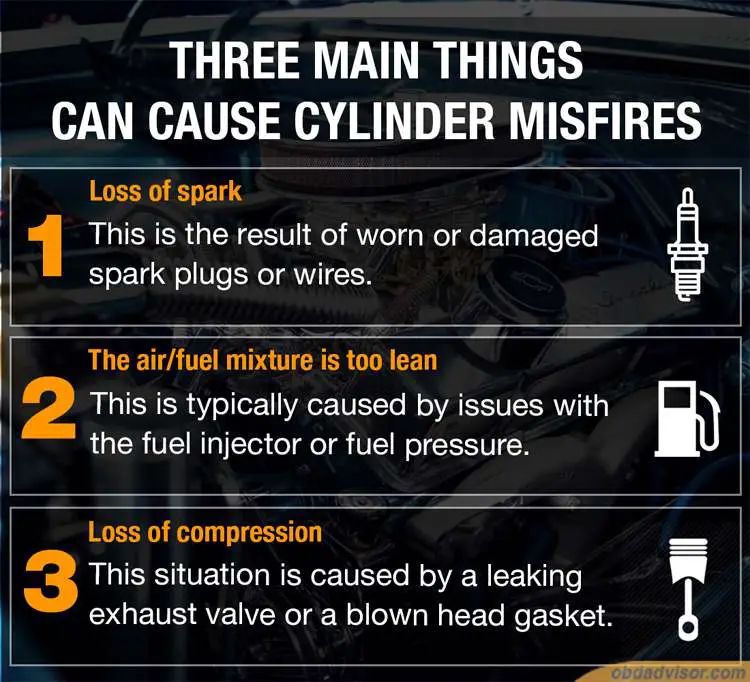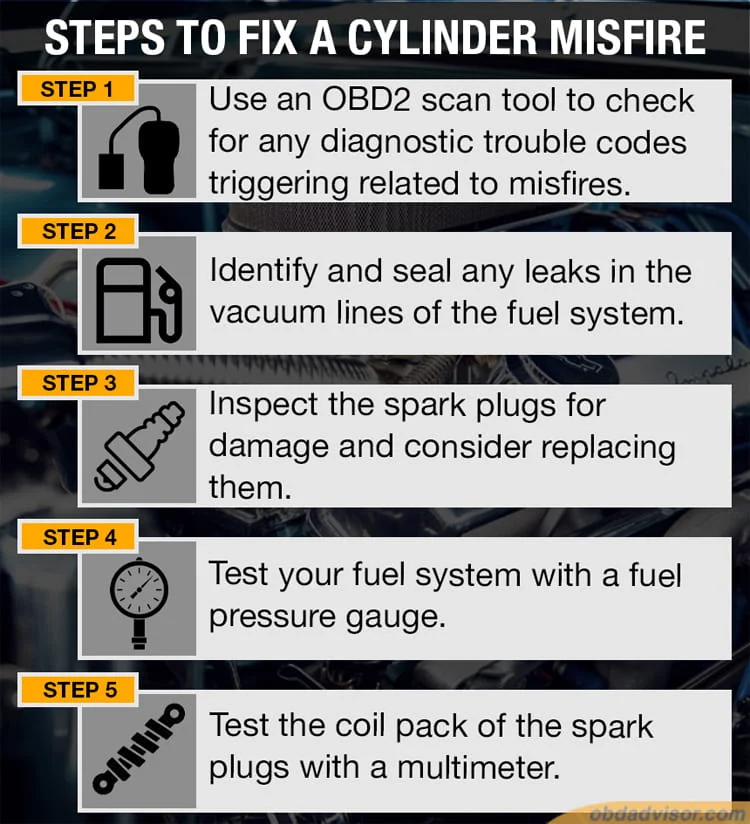Are you wondering, “How long can I drive with a misfiring cylinder?”
Then you’ve come to the right place!
This article will answer your question (It is mentioned in part 3) and show you what to do if you think your car’s having this problem.
But first, you need to know the causes of misfires and how to identify them.
Let’s get started!
3 Common Causes of a Cylinder Misfire
Three main things can cause cylinder misfires:

- Loss of spark. This is when the electrical spark is prevented from jumping the electrode gap at the spark plug’s end. It is typically the result of worn or damaged spark plugs or wires.
- The air/fuel mixture is too lean. If there’s too much air in the air/fuel mixture, there’s not enough gasoline in the mix to ignite. This is usually because of issues with the fuel injector or fuel pressure.
- Loss of compression. This happens when the air/fuel mixture is lost from the cylinder before it can ignite. It’s commonly caused by a leaking exhaust valve or a blown head gasket.
What Happens When a Cylinder Misfires
You will notice a significant loss of power from a driver’s perspective if you are experiencing misfires. It means one of the cylinders is not generating power, so in a four-cylinder engine, that is a 25% drop in engine output.
Other misfire signs include a sudden drop in fuel economy or a sudden increase in harmful emissions.
The engine may also shake when it is idling. Sometimes, you can feel the vibrations through the steering wheel, and you can experience stalls.
How Long Can I Drive with a Misfiring Cylinder?
Theoretically, you could drive thousands of miles with a misfiring cylinder in most vehicles. The other cylinders in the engine will continue to provide power. So though you may shake and stall along the wall (and will not get much in the way of speed or acceleration), the vehicle will still run.
That said, you should not drive a car with a misfiring cylinder any further than you have to.
Many modern cars will go into “limp mode” when a misfire is detected, limiting the maximum speed and making the car annoying to drive.
Therefore, you can drive for a while with a misfiring cylinder.
The best answer is that you should only drive it as far as the nearest mechanic or safe place to stop, then make repairs before going any further.
Is it Bad to Drive with a Misfire?
Yes. It can be dangerous to drive with a misfiring cylinder.
First of all, you could lose engine power completely if a second cylinder goes out, as well. This can lead to accidents if it happens when you are not expecting it.
Misfires can also cause engine damage over time. When you have misfires, the fuel in the chamber is not burning properly.
This means fuel enters the catalytic converter and increases its heat, potentially causing damage. It can also damage the pistons and cylinders or cause warping in the valves and pistons.
How to Fix a Cylinder Misfire
The first step to making repairs is identifying the root of the problem. For most people, the easiest option is to head to a mechanic. That said, if you are a DIYer and want to give it a shot, here is how you can go about repairing a misfire:

Step 1: Use an OBD2 scan tool to check for any diagnostic trouble codes that have been triggered related to misfires.
This can help to guide your diagnosis.
Even codes unrelated to misfires can sometimes help, such as a code regarding the fuel delivery system, MAF sensor, or oxygen sensors, resulting from the same issues causing the misfire.
Step 2: Identify and seal any leaks in the vacuum lines of the fuel system. Air leaks are one of the leading causes of a bad air/fuel ratio, a common cause of misfires.
Step 3: Inspect the spark plugs for damage. If they are soiled with oil or worn, replace them.
Step 4: Test your fuel system with a fuel pressure gauge. If the reading is low or inconsistent, you likely need to replace the fuel filter or the fuel pump itself.
Step 5: Test the coil pack of the spark plugs with a multimeter. The resistance should be the same across the spark plug wires. If it is not, a coil needs to be replaced.
Since there are various potential causes for misfires, diagnosing, and repairing the problem can be tricky. This is one reason why it is often best to go to a mechanic unless you are an experienced DIYer.
The Bottom Line
Now that you’ve read this post, you already know that you can drive with a misfiring cylinder but just for a while.
Engine misfires can be dangerous and hazardous, so you want to take them seriously.
If you have an OBD2 code reader, it can help you to identify and repair this problem. Once you’ve addressed the underlying cause, you can get back on the road worry-free.
Have you ever stubbornly driven a long distance with a misfiring cylinder? Does it lead to any serious consequences?
Let me know your experience in the comment section below.
Learn more:
How To Test O2 Sensor With A Scanner?: A detailed guide on “How To Read O2 Sensor Live Data (Normal & Bad Condition)”
P0300 – Random/Multiple Cylinder Misfire Detected: A complete article to provide you with the Meaning, Symptoms, Causes, and Diagnostic Steps of Random/Multiple Cylinder Misfire Detected.
Symptoms of a car misfiring while driving: An excellent video that shows you 5 specific symptoms of driving with a misfiring cylinder.